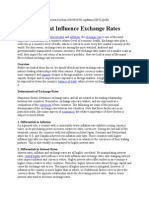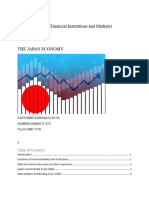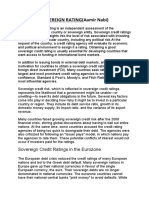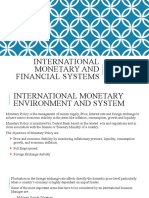International Country Risk: An Overview of Financial Management and The Financial Environment
International Country Risk: An Overview of Financial Management and The Financial Environment
Uploaded by
adrien_ducaillouCopyright:
Available Formats
International Country Risk: An Overview of Financial Management and The Financial Environment
International Country Risk: An Overview of Financial Management and The Financial Environment
Uploaded by
adrien_ducaillouOriginal Description:
Original Title
Copyright
Available Formats
Share this document
Did you find this document useful?
Is this content inappropriate?
Copyright:
Available Formats
International Country Risk: An Overview of Financial Management and The Financial Environment
International Country Risk: An Overview of Financial Management and The Financial Environment
Uploaded by
adrien_ducaillouCopyright:
Available Formats
18 Chapter 1 An Overview of Financial Management and the Financial Environment
must borrow, and as we increase our borrowing, this drives up interest rates. Also, international investors are willing to hold U.S. debt if and only if the rate paid on this debt is competitive with interest rates in other countries. Therefore, if the Federal Reserve attempts to lower interest rates in the United States, causing our rates to fall below rates abroad (after adjustments for expected changes in the exchange rate), then international investors will sell U.S. bonds, which will depress bond prices and result in higher U.S. rates. Thus, if the trade deficit is large relative to the size of the overall economy, it will hinder the Feds ability to combat a recession by lowering interest rates. The United States has been running annual trade deficits since the mid-1970s, and the cumulative effect of these deficits is that the United States has become the largest debtor nation of all time. As a result, our interest rates are very much influenced by interest rates in other countries around the world: Higher rates abroad lead to higher U.S. rates, and vice versa. Because of all this, U.S. corporate treasurersand anyone else who is affected by interest rates must keep up with developments in the world economy. International Country Risk International risk factors may increase the cost of money that is invested abroad. Country risk is the risk that arises from investing
Interest Rates Inflation Interest Rate (%)
16 14 12 10 8 6 4 2 0 16 14 12 10 8 6 4 2 0
1972 1974 1976 1978 1980 1982 1984 1986 1988 1990 1992 1994 1996 1998 2000 2002 2004 2006
Business Activity, Interest Rates, and Inflation
Figure 1-2
Notes: aThe shaded areas designate business recessions as defined by the National Bureau of Economic Research; see http://www.nber.org/cycles. Tick marks represent the beginning of the year. bInterest rates are for AAA corporate bonds; see the St. Louis Federal Reserve Web site known as FRED: http://research.stlouisfed.org /fred/. cInflation is measured by the annual rate of change for the Consumer Price Index (CPI); see http://research.stlouisfed.org/fred/.
You might also like
- International Financial Management 9th Edition Jeff Madura Solutions Manual 1Document15 pagesInternational Financial Management 9th Edition Jeff Madura Solutions Manual 1eleanor100% (52)
- The 2023 Andex Chart StoryDocument3 pagesThe 2023 Andex Chart Storypridetag.contatoNo ratings yet
- Ch.4 Answers To End of Chapter QuestionsDocument9 pagesCh.4 Answers To End of Chapter Questionspoiriejs100% (5)
- Summary of Anthony Crescenzi's The Strategic Bond Investor, Third EditionFrom EverandSummary of Anthony Crescenzi's The Strategic Bond Investor, Third EditionNo ratings yet
- Chapter 1 Financial Management in Global ContextDocument46 pagesChapter 1 Financial Management in Global ContextKRUPALI RAIYANINo ratings yet
- The Structure and Functions of The Federal Reserve System: Policy, Banking Supervision, Financial ServicesDocument18 pagesThe Structure and Functions of The Federal Reserve System: Policy, Banking Supervision, Financial ServicesJapish MehtaNo ratings yet
- International FINANCIALDocument32 pagesInternational FINANCIALVinodh Kumar LNo ratings yet
- IRL 3109 - Lecture 6 (2020-12-10)Document26 pagesIRL 3109 - Lecture 6 (2020-12-10)nolissaNo ratings yet
- RizwanDocument9 pagesRizwanRizwan BashirNo ratings yet
- Factors That Influence Exchange RatesDocument2 pagesFactors That Influence Exchange RatesJoelene ChewNo ratings yet
- ZebrawhiteDocument12 pagesZebrawhitechrisNo ratings yet
- International Financial Management 9th Edition Jeff Madura Solutions Manual 1Document36 pagesInternational Financial Management 9th Edition Jeff Madura Solutions Manual 1paulagomezcjsqfeaoyi100% (40)
- Tugas Bisnis Internasional Financial ForcesDocument5 pagesTugas Bisnis Internasional Financial ForcesPutry AgustinaaNo ratings yet
- PFM15e IM CH19Document11 pagesPFM15e IM CH19Daniel HakimNo ratings yet
- Determining Exchange Rate: TopicDocument24 pagesDetermining Exchange Rate: TopicGreeshma SinghNo ratings yet
- Optimism Prevails As Neda Chief Confident PH Will Hit Growth Target - Sept 19, 2019Document8 pagesOptimism Prevails As Neda Chief Confident PH Will Hit Growth Target - Sept 19, 2019Mavic PeñalozaNo ratings yet
- Singapore Property Weekly Issue 208Document17 pagesSingapore Property Weekly Issue 208Propwise.sgNo ratings yet
- Why Rates FluctuateDocument2 pagesWhy Rates Fluctuateprajaktabansod.89No ratings yet
- Differentials in Inflation: Cost-Push Inflation Versus Demand-Pull InflationDocument2 pagesDifferentials in Inflation: Cost-Push Inflation Versus Demand-Pull InflationKirat GillNo ratings yet
- HW 1Document5 pagesHW 1Marino NhokNo ratings yet
- International Financial Management 9th Edition Madura 032459349X 9780324593495 Solution ManualDocument36 pagesInternational Financial Management 9th Edition Madura 032459349X 9780324593495 Solution Manualjasonmorales05091999asr100% (42)
- The Global Financial Crisis - Causes and Solutions.Document5 pagesThe Global Financial Crisis - Causes and Solutions.Sherlene GarciaNo ratings yet
- Chapter 17Document29 pagesChapter 17ragi malikNo ratings yet
- DownloadDocument4 pagesDownloadmanirajpoot45No ratings yet
- Monetary Policy.: Economic Money Credit InterestDocument27 pagesMonetary Policy.: Economic Money Credit Interestchemy_87No ratings yet
- What Determins Intrest RateDocument4 pagesWhat Determins Intrest RateAbdullah MalikNo ratings yet
- Exchange Rate Determination: South-Western/Thomson Learning © 2006Document24 pagesExchange Rate Determination: South-Western/Thomson Learning © 2006Praveen JaganNo ratings yet
- International Financial Management: The Outlook of The World Through Domestic MarketsDocument49 pagesInternational Financial Management: The Outlook of The World Through Domestic MarketsSuryansh IvaturiNo ratings yet
- Account Deficit US Financial CrisisDocument31 pagesAccount Deficit US Financial CrisisPurnendu SinghNo ratings yet
- Identify The Possible Exchange Rate RiskDocument6 pagesIdentify The Possible Exchange Rate RiskSalman SajidNo ratings yet
- Reading Lesson 6Document8 pagesReading Lesson 6AnshumanNo ratings yet
- Factors Influencing Exchange RatesDocument2 pagesFactors Influencing Exchange RatesPravin Kumar PNo ratings yet
- Main Factors That Influence Exchange Rate.: 1. InflationDocument9 pagesMain Factors That Influence Exchange Rate.: 1. InflationHiren GanganiNo ratings yet
- 6 Factors That Influence Exchange RatesDocument2 pages6 Factors That Influence Exchange RatesfredsvNo ratings yet
- Market Commentary 11-26-12Document3 pagesMarket Commentary 11-26-12CLORIS4No ratings yet
- Financial Crisis Means: IntroductionDocument3 pagesFinancial Crisis Means: IntroductionKaushlya DagaNo ratings yet
- Unit 1: Introduction: I. Key TermsDocument5 pagesUnit 1: Introduction: I. Key TermsPhương AnhNo ratings yet
- GLOBAL SYNOPSIS-updatedDocument26 pagesGLOBAL SYNOPSIS-updatedAbhishek pathangeNo ratings yet
- Final Report Fim Zain and MaheerDocument12 pagesFinal Report Fim Zain and Maheerzainfarooqui123456789No ratings yet
- Sovereign Rating (Aamir Nabi) : Sovereign Credit Ratings in The EurozoneDocument25 pagesSovereign Rating (Aamir Nabi) : Sovereign Credit Ratings in The EurozoneDaheem AminNo ratings yet
- Effects of Foreign Exchange Rates On Indian EconomyDocument43 pagesEffects of Foreign Exchange Rates On Indian EconomyMohamed Rizwan0% (1)
- International FinanceDocument36 pagesInternational FinanceHetal bariaNo ratings yet
- Summary MKI Chapter 4Document4 pagesSummary MKI Chapter 4DeviNo ratings yet
- International Monetary and Financial Systems - Chapter-4 MbsDocument62 pagesInternational Monetary and Financial Systems - Chapter-4 MbsArjun Mishra100% (1)
- Flow of PresentationDocument7 pagesFlow of PresentationIbad RajaNo ratings yet
- Workers and Unions Structural AdjustmentsDocument47 pagesWorkers and Unions Structural AdjustmentsveeerajNo ratings yet
- Domestic Monetary STabilityDocument30 pagesDomestic Monetary STabilityJhay Zem OrtizNo ratings yet
- Factors Affecting Exchange RatesDocument2 pagesFactors Affecting Exchange Ratesanish-kc-8151No ratings yet
- Exchange Rates Foreign-Exchange Rate, Forex Rate or FX Rate)Document5 pagesExchange Rates Foreign-Exchange Rate, Forex Rate or FX Rate)SaadRasheedNo ratings yet
- F9FM-Session17 d08xsxDocument16 pagesF9FM-Session17 d08xsxErclanNo ratings yet
- Soa University: Name: Gunjan DasDocument7 pagesSoa University: Name: Gunjan Das87 gunjandasNo ratings yet
- Shin PreonDocument30 pagesShin PreonEric WhitfieldNo ratings yet
- If Assignmengt 1Document6 pagesIf Assignmengt 1Noor AmjadNo ratings yet
- BankingDocument41 pagesBankingYUYOU WANGNo ratings yet
- Impact of Rising Interest Rates On Equity MarketsDocument9 pagesImpact of Rising Interest Rates On Equity MarketsDeepak DharmavaramNo ratings yet
- EMs Global IRVolDocument6 pagesEMs Global IRVolemailrobertguyNo ratings yet
- Chapter 1-IBF IntroductionDocument61 pagesChapter 1-IBF IntroductionHay JirenyaaNo ratings yet
- Assignment 3 ECON 401Document4 pagesAssignment 3 ECON 401aleena asifNo ratings yet
- Epr 2022 Fima-Repo ChoiDocument22 pagesEpr 2022 Fima-Repo ChoiKelvin MishoshoNo ratings yet
- 2.2 Future Values: Values (PVS) Is Called Compounding. To Illustrate, Refer Back To Our 3-Year Time LineDocument1 page2.2 Future Values: Values (PVS) Is Called Compounding. To Illustrate, Refer Back To Our 3-Year Time Lineadrien_ducaillouNo ratings yet
- A Preview of What Is Ahead 31Document1 pageA Preview of What Is Ahead 31adrien_ducaillouNo ratings yet
- Formula Approach: FV PMT PV I/YrDocument1 pageFormula Approach: FV PMT PV I/Yradrien_ducaillouNo ratings yet
- Graphic View of The Discounting Process: Self-TestDocument1 pageGraphic View of The Discounting Process: Self-Testadrien_ducaillouNo ratings yet
- Graphic View of The Compounding Process: Self-TestDocument1 pageGraphic View of The Compounding Process: Self-Testadrien_ducaillouNo ratings yet
- 2.1 Time Lines: Time Value of Money, Also Called Discounted Cash Flow (DCF) Analysis. Since TimeDocument1 page2.1 Time Lines: Time Value of Money, Also Called Discounted Cash Flow (DCF) Analysis. Since Timeadrien_ducaillouNo ratings yet
- Time Value of MoneyDocument2 pagesTime Value of Moneyadrien_ducaillouNo ratings yet
- Spreadsheets: One Payment Per Period. Many Calculators "Come Out of The Box" AssumingDocument1 pageSpreadsheets: One Payment Per Period. Many Calculators "Come Out of The Box" Assumingadrien_ducaillouNo ratings yet
- Step-by-Step Approach: Corporate Valuation and The Time Value of MoneyDocument1 pageStep-by-Step Approach: Corporate Valuation and The Time Value of Moneyadrien_ducaillouNo ratings yet
- Future Values 43: Figure 2-1Document1 pageFuture Values 43: Figure 2-1adrien_ducaillouNo ratings yet
- An Overview of Financial Management and The Financial EnvironmentDocument1 pageAn Overview of Financial Management and The Financial Environmentadrien_ducaillouNo ratings yet
- Mini Case: An Overview of Financial Management and The Financial EnvironmentDocument1 pageMini Case: An Overview of Financial Management and The Financial Environmentadrien_ducaillouNo ratings yet
- Summary 33Document1 pageSummary 33adrien_ducaillouNo ratings yet
- Stock Market Returns 29Document1 pageStock Market Returns 29adrien_ducaillouNo ratings yet
- Dow Jones Industrial Average: The Secondary Stock Markets 27Document2 pagesDow Jones Industrial Average: The Secondary Stock Markets 27adrien_ducaillouNo ratings yet
- 1.9 Types of Stock Market Transactions: Network (ECN) - Participants in An ECN Post Their Orders To Buy and Sell, andDocument1 page1.9 Types of Stock Market Transactions: Network (ECN) - Participants in An ECN Post Their Orders To Buy and Sell, andadrien_ducaillouNo ratings yet
- 1.7 Types of Financial Markets: An Overview of Financial Management and The Financial EnvironmentDocument1 page1.7 Types of Financial Markets: An Overview of Financial Management and The Financial Environmentadrien_ducaillouNo ratings yet
- International Trade Deficits or Surpluses: Table 1-1Document1 pageInternational Trade Deficits or Surpluses: Table 1-1adrien_ducaillouNo ratings yet
- Financial Institutions 21Document1 pageFinancial Institutions 21adrien_ducaillouNo ratings yet
- An Overview of Financial Management and The Financial EnvironmentDocument1 pageAn Overview of Financial Management and The Financial Environmentadrien_ducaillouNo ratings yet
- 1.5 Financial Securities and The Cost of Money: Self-TestDocument1 page1.5 Financial Securities and The Cost of Money: Self-Testadrien_ducaillouNo ratings yet
- Banking House Such As Merrill Lynch, Which Underwrites The Issue. AnDocument1 pageBanking House Such As Merrill Lynch, Which Underwrites The Issue. Anadrien_ducaillouNo ratings yet
- Reluctant Users Slow To Take Up Videoconferencing: Untr 2Document2 pagesReluctant Users Slow To Take Up Videoconferencing: Untr 2adrien_ducaillou0% (1)
- 1.4 An Overview of The Capital Allocation Process: Self-TestDocument1 page1.4 An Overview of The Capital Allocation Process: Self-Testadrien_ducaillouNo ratings yet
- AcademicCalendar2013 2014 approvedFINAL270312Document1 pageAcademicCalendar2013 2014 approvedFINAL270312adrien_ducaillouNo ratings yet
- Upstream Oil and Gas in China: V. Industry Sector ReportsDocument34 pagesUpstream Oil and Gas in China: V. Industry Sector Reportsadrien_ducaillouNo ratings yet





















































































